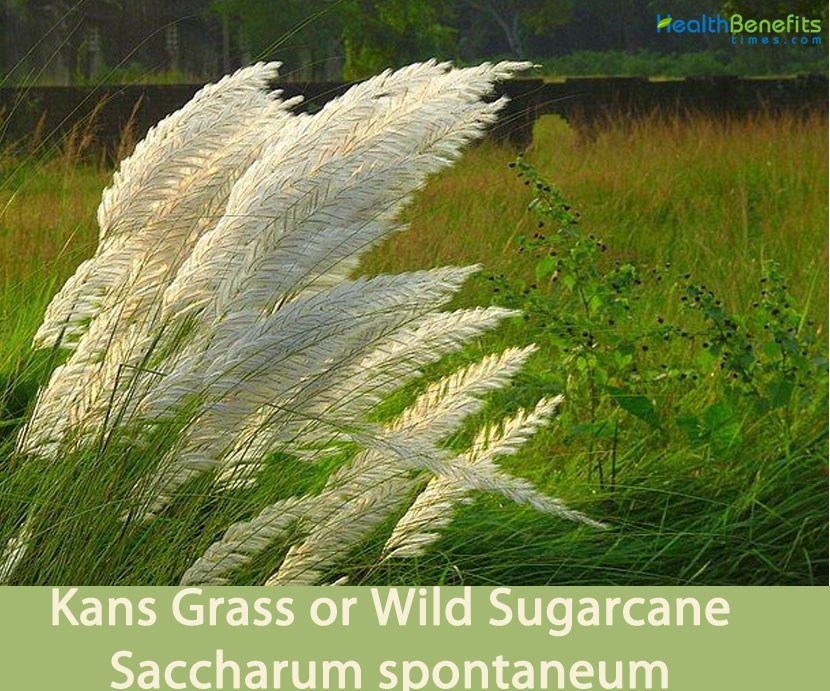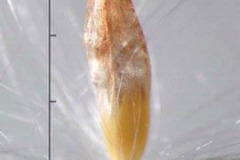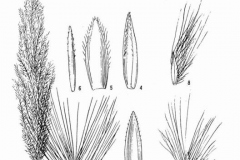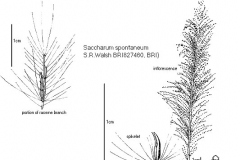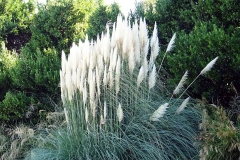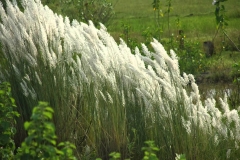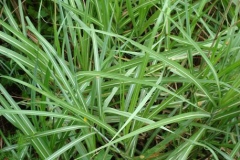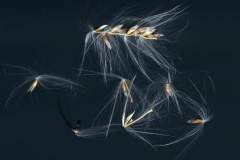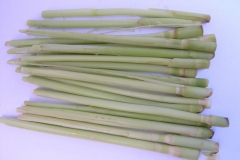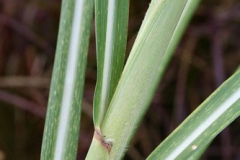Genus name Saccharum is derived from Greek term ‘saccharon’ (sugar or sweet juice), in reference to the sugarcane genus. Species epithet ‘spontaneum’ means ‘spontaneous’, probably refers to the plant’s fast growth and ability to colonize disturbed areas readily. It is an important habitat for the Indian rhinoceros. In Nepal, Kans grass is harvested to thatch roofs or fence vegetable gardens. In the Terai region, it quickly colonizes exposed silt plains created each year by the retreating monsoon floods, forming almost pure stands on the lowest portions of the floodplain. It has been used in the breeding of sugarcane (S. Officinarum), as it provides vigor, hardiness and resistance to many major diseases. The grass was once considered a weed that infested millions of acres of cultivable land in Central India. India took a loan of 7 million dollars from World Bank in 1949 to buy 200 heavy-duty tractors for removing the grass by deep-ploughing the affected areas to remove the roots and rhizomes.
Kans Grass or Wild Sugarcane Facts
| Kans grass or Wild sugarcane Quick Facts | |
|---|---|
| Name: | Kans grass or Wild sugarcane |
| Scientific Name: | Saccharum spontaneum |
| Origin | South Asia (India). Globally, it is distributed throughout the tropical countries of Asia, Africa, America as well as in tropical Australia |
| Taste | Sweet |
| Health benefits | Dyspepsia, biliousness, burning sensation, blood disorders, hemorrhages, piles, sexual weakness, gynecological troubles and respiratory troubles |
| Name | Kans grass or Wild sugarcane |
|---|---|
| Scientific Name | Saccharum spontaneum |
| Native | South Asia (India). Globally, it is distributed throughout the tropical countries of Asia, Africa, America as well as in tropical Australia. It is often planted in Bangladesh, Sri Lanka, India, Nepal and Pakistan. It is also cultivated in Java and Kalimantan, New Guinea, Melanesia, New Hebrides and Fiji |
| Common Names | Wild sugarcane, serio grass, thatch grass, wild grass, wild cane, kans grass, Caña de azúcar Silvestre, Cane Inflorescence, Coastal Pitpit, Cultivated Sugarcane, Duruka, Fiji Asparagus, Pitpit, Vegetable Cane |
| Name in Other Languages | Arabic: Bous El-Gazaier, Heesh, bus aljazayar, qalam (qullm), halfan (halfa) (بوص الجزاير، قلم (قُلّم)، حلفا (حَلفا), bus farsaa, bus qalam (‘aqlamu) (بوص فارسى، بوص قلم (أقلام) Assamese: Kahuva, Khagori,Kahua, Khagra, Khagori, Lihira, Kanhi-bon, Biraiṇā (বিৰিণা) Bangladesh: Kash, Bengali: Keshe, Kāśaphula (কাশফুল), Keshe (केशे), Kagara (कागरा) Bontoc: Sálin Burmese: Kine pain kyee (ကိုင်းပင်ကြီး) Cambodia: Ampeon pixy Cebuano: Bogáng, bugáng, tigbáu Chinese: Tian gen zi cao (甜根子草) Egypt: Boos, boos el-gezzair, boos giddawi, ghazar English: Wild cane, Wild sugar cane, Fodder cane, Thatch grass, serio grass, serio grass, thatch grass, tiger grass, kans grass, shatter cane, sweet cane, talahibgrass Fiji: Duruka French: Canne à sucre fourragère, Canne sauvage, Canne Dauvage, German: Wilde Zuckerrohr Gujarati: Kansado, Kansdo (कांसडो), Kans (कांस) Hindi: Kas (कास), Kaans (काँस), Kasa, kaansee (कांसी), kaans ghaas (कांस घास), kaagara (कागरा), Kusa: (कुस;) Iloko: Liddá Indonesia: Trubus, Tebu Telur, Tebu Bertelor, glagah; tobioe, Gelagah Italian: Canna d’Egitto Japanese: Nangoku wase obana, wase-abana Javanese: Glagah Kannada: Kans Grass,Kadu Kabbu (ಕಾಡು ಕಬ್ಬು), Kasalu (कासलु), Mutullahullu (मुतुलहुल्लु), Hodakehullu (होडाकेहुल्लु) Kapampangan: Palat Khmer: ‘âm’pëu préi Kosraean: Ac Laotian: Ph’ông, Lau Madagascar: Fary Malay: Tebrau putih, Gelagah, Glagah, Tebu salah, Pokok Tebu Gajah Malayalam : Thatchgrass, Njangana, Nannana, Kusa, Kusadarbha, Kuruvikarimbu, Choottapullu, Nannana (नान्नना) Marathi: Kasai, Serio Grass,Kamis, Kasai (कसई), Kagara (कागरा) Mishing: Mojora Myanmar: Thekkaygyee, thetkiakyn Nepali : Kaans (कास), kaans (काँस) New Guinea: Pit-pit Odia– Inkoro (इंकोरो), Kaso (कासो) Pakistan: Kahi Palauan: Banga ruchel Papua New Guinea: Bwêy, Pit, Pitpit Persian: تباشیر خودروی Philippines: Bobang, bugang, gigbau, sidda, talahib Pohnpeian: Ahlec, ahlek, alek Polish: Kaśa Portuguese: Cana-de-açúcar-selvagem Punjabi: Kahi (काहि), Kanh (कांह), Kans (कांस) Russian: Sakharnyi trostnik dikii (сахарный тростник дикий) Sanskrit: Kaasaa, kaash (काश), kaasekshu (कासेक्षु), ikshuras (इक्षुरस), ikshvaalika (इक्ष्वालिका), Ikṣugandhā (इक्षुगन्धा), potagal (पोटगल), Kṣurapatra (क्षुरपत्र), Śvētacāmara (श्वेतचामर) Santali: ᱠᱟᱹᱢᱤᱭᱟᱹ ᱵᱟᱦᱟ Spanish: Caña de azúcar silvestre, Caña Silvestre, paja blanca, paja canalera Sudanese: Kaso Tagalog: Talahib Tahitian: To aheo Tamil: Naangal (நாணல்), Peykkarumpu (பேய்க்கரும்பு), Saccharum biflorum Forssk.,Pekkarimpu, Nanalu (नाणलू), Kucham (कुचम) Telugu: Vettiicheraku, Rellu gaddi, Kaki Ceruku (కాకిచెరకు), Rellugaddi (रेलुगड्डी), Rasalamu (रसलामू) Thai: Phā (พา), Phong, Lea (เลา ), X̂xy p̀ā t̄hæb r̂xn (อ้อยป่าแถบร้อน) Vanuatu: Naviso Venezuela: Cana uba Vietnamese: Co’lách, Lách |
| Plant Growth Habit | Erect, tough perennial tillering herb |
| Growing Climates | Foot slopes, drainage lines, seepage areas, river banks, roadsides, railroads, waste ground, banks of lakes and ponds, swamps, saline swamps, deserts, jungles, sandy river flats, low slopes |
| Soil | Thrives on deep- and fine-textured soils of lowland plains subject. A fertile soil and adequate rainfall ensure good quality yields |
| Plant Size | Up to 8 meters, but normally within the range 2 – 3.5 meters |
| Culms | Culms remain green, grey, ivory or white, hard, but very pithy and often hollow in the center, varying in diameter from 5 to 15 mm; often rooting at the nodes |
| Glumes | Glumes are similar, firmer than fertile lemma. Lower glume is lanceolate, 100% of length of spikelet, coriaceous or indurate, much thinner above. Lower glume surface is flat. Lower glume margins ciliate |
| Leaf | Leaf sheath glabrous, with overlapping margins; ligule membranous, 3-4 mm long, with a rounded apex fringed with scattered hairs and a dense row of hairs 2-3 mm long behind it. Leaf blade mostly 50-90 x 5-15 cm |
| Spikelets | Spikelets are found in pairs, one sessile and fertile and the other (companion) spikelet is pedicelled, and sub equal. Pedicels are linear, ciliate. Companion spikelets are bisexual. Fertile spikelets are 2-flowered, comprising 1 fertile floret, without rhachilla extension |
| Propagation | By Wind-dispersed seed |
| Taste | Sweet |
| Plant Parts Used | Whole plant, root stock |
| Precautions |
|
Plant Description
Kans grass or Wild sugarcane is a deep-rooted, coarse, erect, tough perennial tillering herb that normally grows up to 8 meters, but normally within the range 2 – 3.5 meters with spreading rhizomatous roots and occasionally creeping rhizomes. It is highly polymorphic with plant morphotypes ranging from small bunchgrass, stalk less plants to plants with six-meter tall stalks. The plant grows in stools or forming continuous cane-brakes and usually exhibiting vigorous rhizomatous tillering. Culms remain green, grey, ivory or white, hard, but very pithy and often hollow in the center, varying in diameter from 5 to 15 mm; often rooting at the nodes, internodes usually long and nodes always thicker than internodes. Culms produce long, silky white panicles, 50-60 cm long.
The plant is found growing in foot slopes, drainage lines, seepage areas, river banks, roadsides, railroads, waste ground, banks of lakes and ponds, swamps, saline swamps, deserts, jungles, sandy river flats, low slopes. It thrives on deep- and fine-textured soils of lowland plains subject. A fertile soil and adequate rainfall ensure good quality yields.
Leaves
Leaf sheath are glabrous, with overlapping margins; ligule is membranous, 3-4 mm long, with a rounded apex fringed with scattered hairs and a dense row of hairs 2-3 mm long behind it. Leaf blade is mostly 50-90 cm long and 5-15 cm wide. Leaves are narrow-lanceolate, involute, with long hairs at base; ligule short. The stomata on the abaxial leaf surface are located in the veinal grooves and are covered by a spine-like silicaceous structure.
Glumes
Glumes are similar, firmer than fertile lemma. Lower glume is lanceolate, 100% of length of spikelet, coriaceous or indurate, much thinner above. Lower glume surface is flat. Lower glume margins ciliate. Lower glume is apex acuminate. Upper glume is linear or lanceolate, 100% of length of spikelet, coriaceous, much thinner above, and 1-nerved. Upper glume lateral nerves absent. Upper glume margins ciliate. Upper glume is apex acute and mucronate.
Spikelet
Spikelets are found in pairs, one sessile and fertile and the other (companion) spikelet is pedicelled, and sub equal. Pedicels are linear, ciliate. Companion spikelets are bisexual. Fertile spikelets are 2-flowered, comprising 1 fertile floret, without rhachilla extension, lanceolate, dorsally compressed, 2–7 mm long, falling entire, deciduous from the base or with accessory branch structures. Spikelet callus is bearded, base truncate. Spikelet callus hairs are white, 200–300% of length of spikelet.
Florets
Basal sterile floret is without significant palea. Lemma of lower sterile floret is linear or lanceolate, 2.5 mm long, 50% of length of spikelet, hyaline, 0-nerved, glabrous, acute. Fertile lemma is linear, 1–2 mm long, hyaline, 0-nerved. Palea is absent or minute. Lodicules are cuneate, ciliate.
Traditional uses and benefits of Kans grass or Wild sugarcane
- The roots are a traditional herb used in the treatment of gynecological troubles and respiratory diseases and are used as galactagogue and diuretic in the Ayurveda system.
- Kans grass or Wild sugarcane is one of the important medicinal plants in traditional systems of medicine in India according to Ayurveda.
- Roots of the plant are sweet, astringent, emollient, refrigerant, diuretic, lithotriptic, purgative, tonic, aphrodisiac and used in the treatment of dyspepsia, burning sensation, piles, sexual weakness, gynecological troubles, respiratory troubles etc.
- Fresh juice of plant stem is also used in the treatment of mental illness and disturbances by different tribes in India.
- In Philippines, numerous medicinal uses have been described.
- It can soothe irritated skin and heal wounds.
- It is used to treat indigestion, and to relieve biliousness, as well as to cool the body.
- Leaves can be heated and used in a poultice to relieve the inflammation of painful joints, perhaps as a result of arthritis or rheumatism.
- It can also be used as a purgative and the aerial parts are supposed to have aphrodisiac qualities.
- In India it is used for erectile dysfunctions, gynecological problems and respiratory disorders among other ailments.
- Decoction made from the roots and rhizomes of the wild sugar cane, or Kans grass is used to promote milk in breast feeding mothers and as a diuretic.
- Decoction of the top parts of the plant is used for blood disorders, hemorrhages and biliousness among other things.
- It may help in kidney’s problem and blood impurity.
- It is used to treat urinary disorders, remove kidney stones and eliminate severe thirst.
- It helps in the treatment of diseases of the female reproductive system menorrhagia and uterine bleeding.
- It promotes increased lactation in nursing mothers.
Culinary Uses
- Edible unopened inflorescences, which are relished as a vegetable either raw or cooked, steamed or roasted in various dishes.
- They are used in soups or curries or added to many dishes, roasted over fire or baked in lovo and eaten.
- In Fiji, it is normally cooked in coconut cream and served as a vegetable, often with fish.
- Apart from canning, it can be vacuum-packed to extend its availability in the market.
- Young shoots are boiled and eaten with rice in Indonesia.
- Canes are a source of sugar, though the sucrose content is low and the fiber content high.
- Hearts of the young shoots can be eaten raw or cooked as a side dish with rice.
- Very young inflorescences, whilst still enclosed by the leaf sheaths, eaten raw, steamed or roasted.
- Peeled rhizomes have a sweet flavor and are chewed by children as a substitute for sugar cane.
- The ash from burnt plants is used as a salt substitute.
- In Indonesia, the young shoots are boiled and enjoyed with rice.
Other Facts
- Leaves are good thatching material and used by local people in the making of ropes, mats, baskets, broom, huts, etc.
- It has, however, been reported as good fodder for goats and camels and suitable for the production of silage.
- Its extensive rhizome network makes it a very efficient binder of soils, and hence, particularly useful for controlling and preventing soil erosion.
- Pulp is suitable for wrapping, writing, and printing and for the production of grease-proof paper.
- Plants are used for hedging or screening.
- It is reported as fodder for goats and camels (Thakur 1984) in juvenile stage and suitable for the production of silage.
Prevention and Control
Due to the variable regulations around (de)registration of pesticides, your national list of registered pesticides or relevant authority should be consulted to determine which products are legally allowed for use in your country when considering chemical control. Pesticides should always be used in a lawful manner, consistent with the product’s label.
Cultural Control
Deep ploughing is an effective ways for the control of this weed. In the Bundelkand regions of Uttar Pradesh, India, a specialized plough known as the ‘Bakhkhar plough’, capable of cultivation to a depth of 26 cm is used to control S. spontaneum. Soil inversion during the months of May and June when the temperature is very high in northern India can help to exhaust food reserves in the rhizomes either by drying or by following inversion with irrigation to encourage regeneration. Regardless of timing, an annual deep cultivation will help to reduce the vigor and spread of this species by systematically interrupting the development of the underground reproductive system.
Embanking and flooding of infested areas can reduce infestations where these occur in localized pockets in the field. Harrowing twice before soybean sowing is followed by one hand weeding 20 days after sowing is effective for control in soybean. Under low rainfall conditions, a double-wheeled hoe may be used for inter-row weed control.
Number of mulching techniques has proved successful for the control of S. spontaneum. Covering the soil surface with black or white polyethylene sheeting after removing above-ground parts, either by herbicide or cultivation, for a period of three to four months prevents regeneration of plants. The stacking of pearl millet or sorghum stubbles after cutting of the weed to ground level can also aid control.
The stale seed bed technique may be used to encourage S. spontaneum to emerge in the months of April and May by applying frequent irrigations. Emerged populations may then be treated with pre-seeding herbicides, and crops sown two to three days later.
Integrated weed management is successful for perennial weeds such as S. spontaneum where tillage and management practices allow competition in favor of crops. In infested areas, competitive crops such as pearl millet or sorghum should be grown instead of cotton or soyabean.
Chemical Control
Number of herbicides has been successful in controlling S. spontaneum in different cropping systems. These include: pre-emergence application of oxyfluorfen followed by oxyfluorfen + paraquat; haloxyfop-methyl + fluazifop-butyl; bromacil or dalapon; amitrole or glyphosate and atrazine.
In Indonesia, glyphosate controlled S. spontaneum without harming young tea plants. In the Philippines, glyphosate was effective in non-cropped areas and during fallow periods in pineapple cropping systems. Fluazifop-butyl applied twice at 3-month intervals was effective without any phytotoxicity to pineapple.
References:
https://www.itis.gov/servlet/SingleRpt/SingleRpt?search_topic=TSN&search_value=42061#null
http://www.hear.org/pier/species/saccharum_spontaneum.htm
https://npgsweb.ars-grin.gov/gringlobal/taxon/taxonomydetail?id=32625
https://www.cabi.org/isc/datasheet/48162
https://indiabiodiversity.org/species/show/231042
http://www.theplantlist.org/tpl1.1/record/kew-440049
https://en.wikipedia.org/wiki/Saccharum_spontaneum
https://gd.eppo.int/taxon/SACSP
https://hort.purdue.edu/newcrop/CropFactSheets/kans.html
https://plants.usda.gov/home/plantProfile?symbol=SASP
http://www.flowersofindia.net/catalog/slides/Kans%20Grass.html


